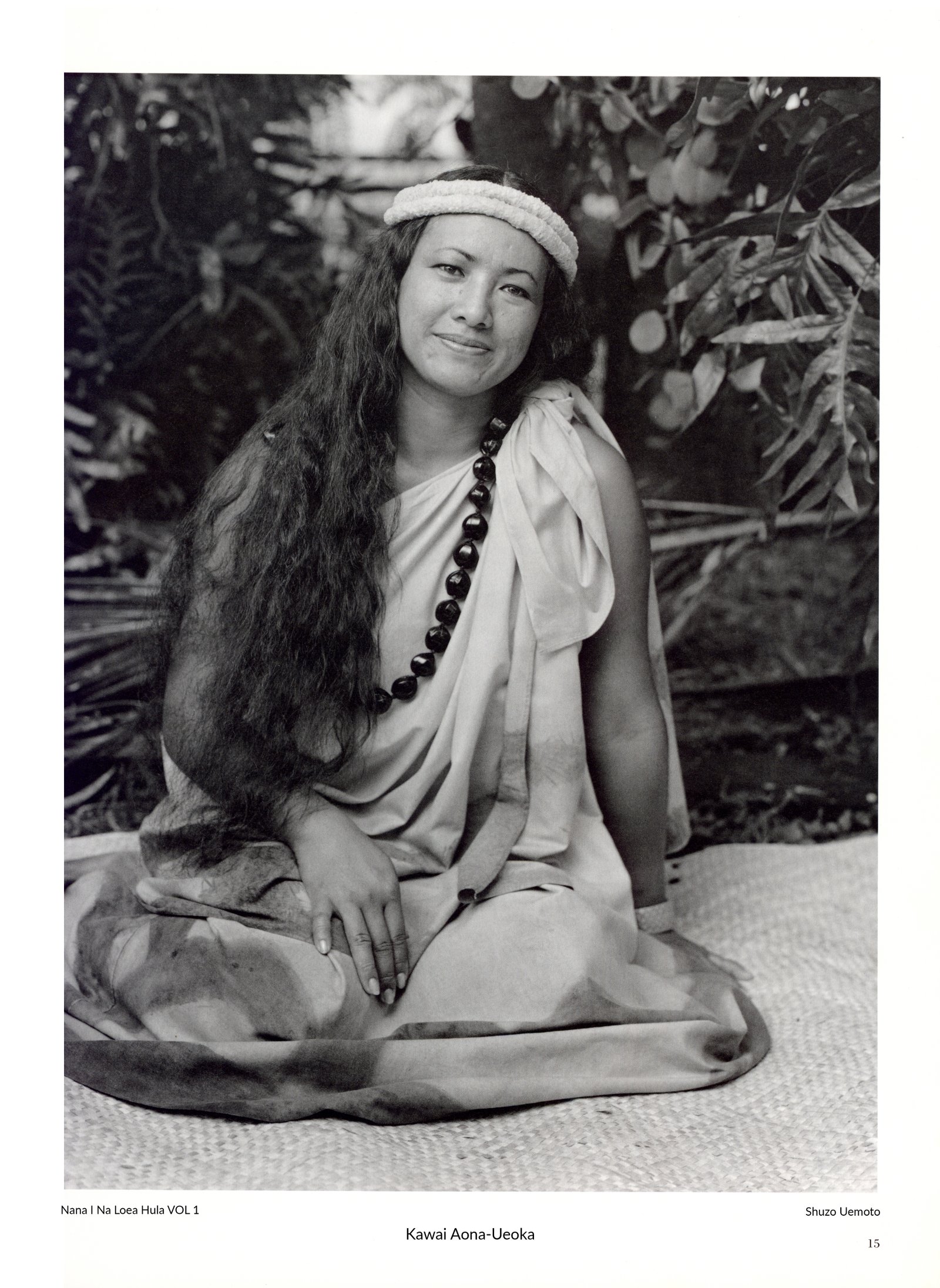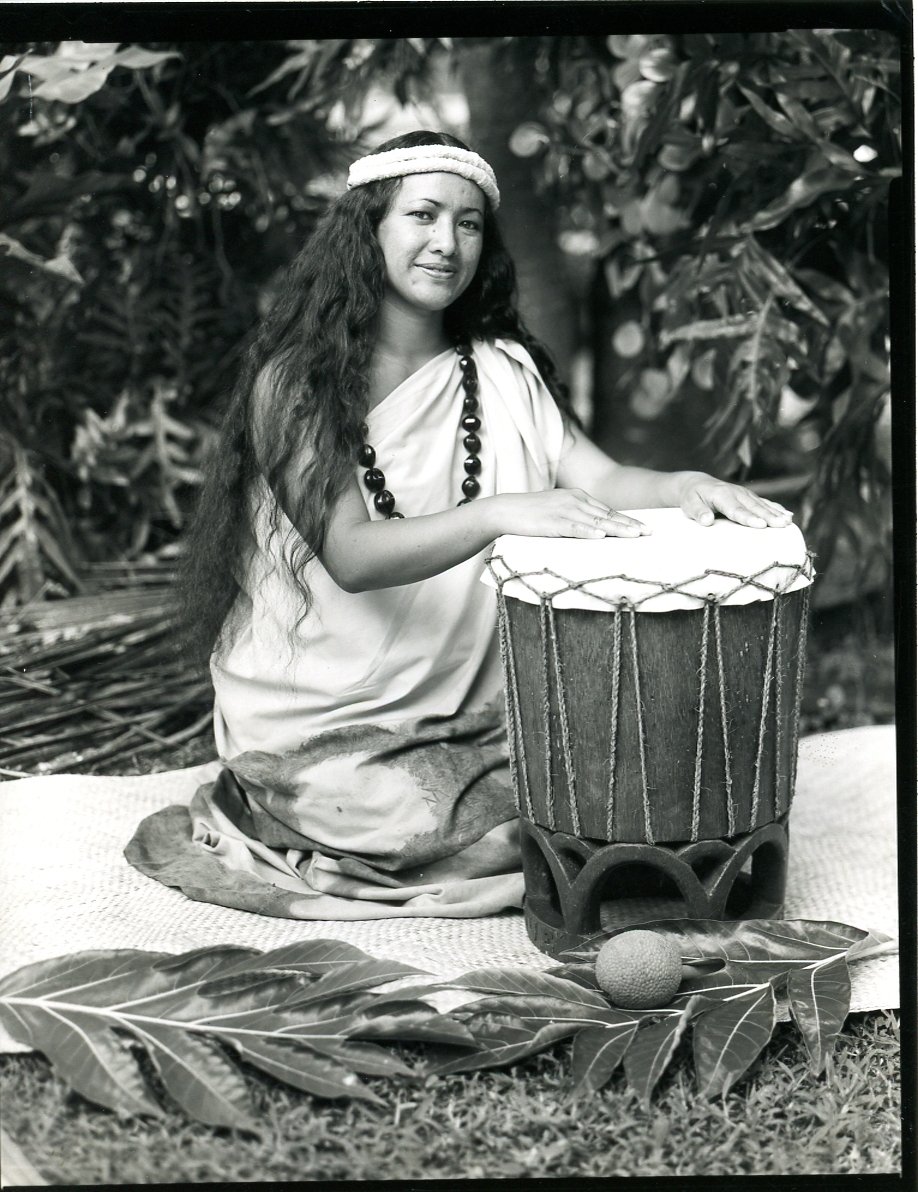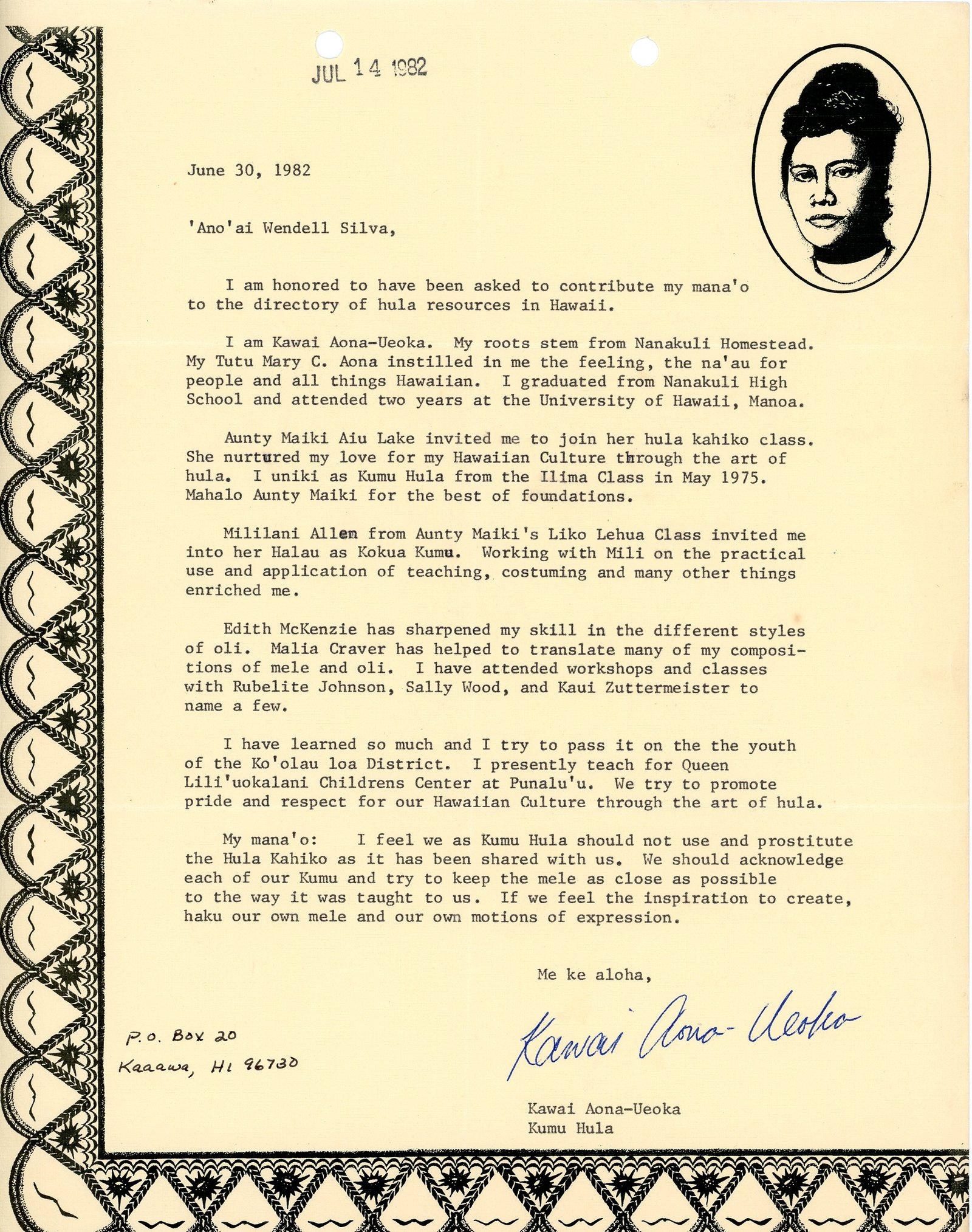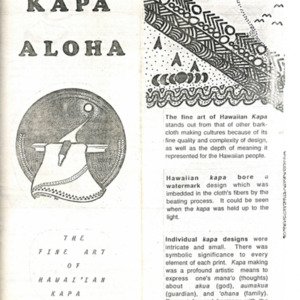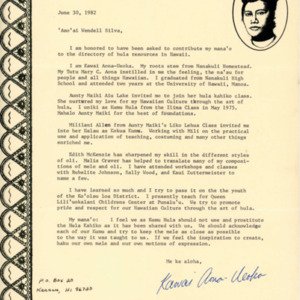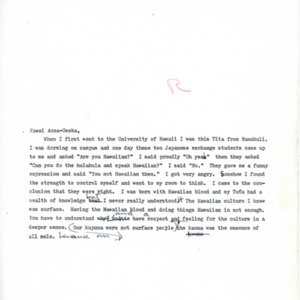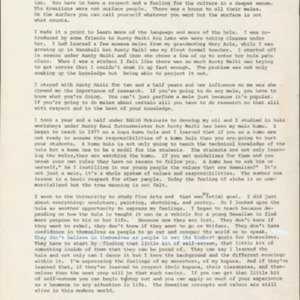Kawai Aona-Ueoka
Title
Kawai Aona-Ueoka
Subject
Nā Kumu Hula Kawai Aona-Ueoka - Nānā I Nā Loea Hula Volume 1 Page 14
Description
Kawai Aona has served as kumu hula for the Queen Liliʻuokalani Childrenʻs Center since 1979.
I was hānai by my Tūtū Mary C. Pua‘ala Aona from the time I was a baby. I knew basic Hawaiian words and phrases and some hula ‘auwana from my tūtū but to me it was nothing because Tūtū could speak Hawaiian fluently, and I’ve been told that she also taught hula kahiko.
When I first went to the University of Hawai‘i, I was this tita from Nanakuli. I was dorming on campus and one day these two Japanese exchange students came up to me and asked, ‘Are you Hawaiian?’ I answered yes proudly and then they asked, ‘Can you do the hula or speak Hawaiian?’ I said no, and they gave me a funny expression and said, ‘You not Hawaiian then.’ I got very angry but I found the strength to control myself and went to my room to think. I came to the conclusion that they were right. I was born with Hawaiian blood and my tūtū had a wealth of knowledge but I never really understood it. The Hawaiian culture I knew was surface. Having the Hawaiian blood and doing things Hawaiian is not enough. You have to understand, and have a respect and feeling for the culture in a deeper sense. The kaona was the essence of all mele because our kupuna were not surface people.
After that incident, I made it a point to learn more of the language and more of the hula. I was introduced to Aunty Mā‘iki Aiu Lake by some friends that were taking hula ‘auwana classes from her. It took about a year of taking ‘auwana classes before Aunty invited a few of us to enter her hula kahiko class. I studied with Aunty Mā‘iki for two and a half years and she made Hawaiian history come alive through the mele. Her requirement for research gave me an understanding of the many things my tūtū had said and done but didn’t know how to explain. I began to understand the depth of Hawaiian values and the importance of respecting all that it stood for.
I graduated traditionally from Aunty Mā‘iki’s ‘Ilima class in 1975, and I went on to Aunty Edith McKinzie who helped to develop my oli by training me in the different styles and techniques of the oli tradition. I began teaching as kumu kokua with Mililani Allen in 1977, and in all my years of growth I have learned that a kumu hula is not just a title but a great responsibility. You are not only the source of technical knowledge but also a model for the behavior of your haumāna. Hula kahiko, as I know it, is a whole system of values and responsibilities that you have to live and believe in. The process of learning and teaching this tradition is never ending and always growing.
I went to the University of Hawai‘i to study fine arts. I was educated in sketching, painting, sculpture, poetry, and photography. They were all art forms from which people could express their feelings. The hula is also an art form from which the kumu hula expresses their manaʻo of our Hawaiian culture but we have to remember that our source is our strength and our essence. We have to hold sacred the teachings of our kumu and the values of our kupuna.
A lot of our young Hawaiians are lost today. They don’t have the confidence in themselves and it’s difficult for them to see how they fit in this ever-changing world of Western values. It’s hard to believe in yourself when you don’t even know what you have to be proud of. What are the concepts behind words like aloha, kōkua, laulima, lōkahi, ‘oia‘i‘o, hō‘ihi, ‘ohana, mālama, and ho‘oponopono? I teach hula with emphasis on cultural understanding, respect, and pride for the elements within each mele as well as its kaona. If my haumāna leave me with a respect for their kupuna, each other and themselves then it will be that much easier to apply the Hawaiian concepts and values in this modern world we live in.
Na ‘Ōpio O Hawai‘i Nei
To dance the hula is to live it
To understand the mele is to seek its kaona
To express the meaning is to feel it
To love the hula is to respect its source
I was hānai by my Tūtū Mary C. Pua‘ala Aona from the time I was a baby. I knew basic Hawaiian words and phrases and some hula ‘auwana from my tūtū but to me it was nothing because Tūtū could speak Hawaiian fluently, and I’ve been told that she also taught hula kahiko.
When I first went to the University of Hawai‘i, I was this tita from Nanakuli. I was dorming on campus and one day these two Japanese exchange students came up to me and asked, ‘Are you Hawaiian?’ I answered yes proudly and then they asked, ‘Can you do the hula or speak Hawaiian?’ I said no, and they gave me a funny expression and said, ‘You not Hawaiian then.’ I got very angry but I found the strength to control myself and went to my room to think. I came to the conclusion that they were right. I was born with Hawaiian blood and my tūtū had a wealth of knowledge but I never really understood it. The Hawaiian culture I knew was surface. Having the Hawaiian blood and doing things Hawaiian is not enough. You have to understand, and have a respect and feeling for the culture in a deeper sense. The kaona was the essence of all mele because our kupuna were not surface people.
After that incident, I made it a point to learn more of the language and more of the hula. I was introduced to Aunty Mā‘iki Aiu Lake by some friends that were taking hula ‘auwana classes from her. It took about a year of taking ‘auwana classes before Aunty invited a few of us to enter her hula kahiko class. I studied with Aunty Mā‘iki for two and a half years and she made Hawaiian history come alive through the mele. Her requirement for research gave me an understanding of the many things my tūtū had said and done but didn’t know how to explain. I began to understand the depth of Hawaiian values and the importance of respecting all that it stood for.
I graduated traditionally from Aunty Mā‘iki’s ‘Ilima class in 1975, and I went on to Aunty Edith McKinzie who helped to develop my oli by training me in the different styles and techniques of the oli tradition. I began teaching as kumu kokua with Mililani Allen in 1977, and in all my years of growth I have learned that a kumu hula is not just a title but a great responsibility. You are not only the source of technical knowledge but also a model for the behavior of your haumāna. Hula kahiko, as I know it, is a whole system of values and responsibilities that you have to live and believe in. The process of learning and teaching this tradition is never ending and always growing.
I went to the University of Hawai‘i to study fine arts. I was educated in sketching, painting, sculpture, poetry, and photography. They were all art forms from which people could express their feelings. The hula is also an art form from which the kumu hula expresses their manaʻo of our Hawaiian culture but we have to remember that our source is our strength and our essence. We have to hold sacred the teachings of our kumu and the values of our kupuna.
A lot of our young Hawaiians are lost today. They don’t have the confidence in themselves and it’s difficult for them to see how they fit in this ever-changing world of Western values. It’s hard to believe in yourself when you don’t even know what you have to be proud of. What are the concepts behind words like aloha, kōkua, laulima, lōkahi, ‘oia‘i‘o, hō‘ihi, ‘ohana, mālama, and ho‘oponopono? I teach hula with emphasis on cultural understanding, respect, and pride for the elements within each mele as well as its kaona. If my haumāna leave me with a respect for their kupuna, each other and themselves then it will be that much easier to apply the Hawaiian concepts and values in this modern world we live in.
Na ‘Ōpio O Hawai‘i Nei
To dance the hula is to live it
To understand the mele is to seek its kaona
To express the meaning is to feel it
To love the hula is to respect its source
Citation
“Kawai Aona-Ueoka,” Nā Kumu Hula Archive, accessed August 25, 2025, https://nakumuhula.org/archive/items/show/30.
